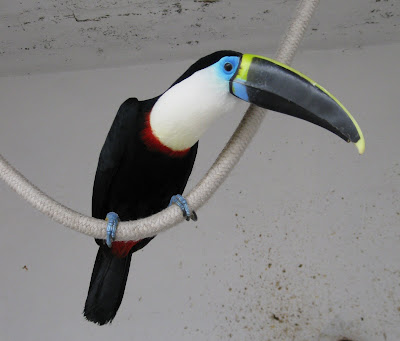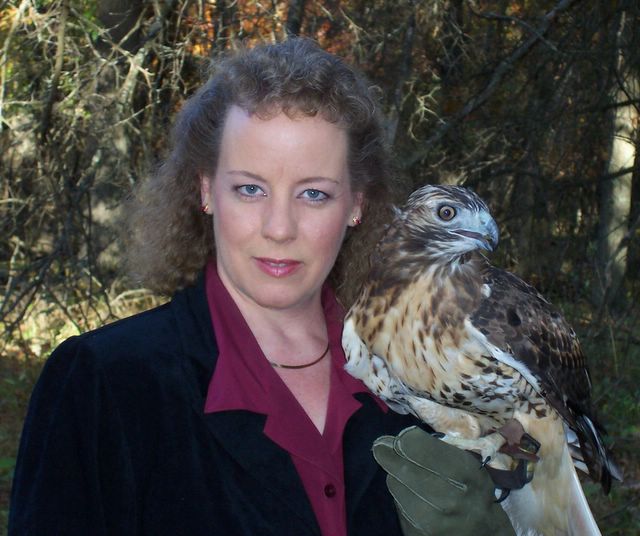More Raptors ~ and a few softbills

Two Falconers, and an exquisite falcon! The bird I am holding is the one Jose currently is flying. He was kind enough to break away from his busy schedule and pick me up in Lima and allow me to freely walk around his facility. I have been given an invitation to return to Peru and see his birds fly . . . an invitation I take seriously and may have to try to follow up on in the next few years to come.
 Above is one of the three large enclosed weathering yards that house many of the raptors produced at El Huayco, ready for transfer to a new falconer within Peru, or exportation. They are individually tied to a bow perch by a leash which is attached to leather straps, called jesses, and anklets that attach to their legs. This is the ancient way of safely perching a raptor which allows for its comfort, but which prevents it from harming other around itself, or breaking feathers or legs. Many birds used in falconry today, especially the falcons, have been bred in human facilities. The breeding of raptors is only successful when the birds are healthy, comfortable in their housing, and satisfied with their mate. Invitro Fertilization is practiced, but I do not believe produced the birds I saw at this facility. Here it is all natural! Jose had a very nicely organized office filled with notebooks and binders of breeding records, and permits. In fact, our afternoon was cut short because he had a meeting with a government official to review through some of his permits and licenses that are a necessary part of keeping these kinds of creatures.
Above is one of the three large enclosed weathering yards that house many of the raptors produced at El Huayco, ready for transfer to a new falconer within Peru, or exportation. They are individually tied to a bow perch by a leash which is attached to leather straps, called jesses, and anklets that attach to their legs. This is the ancient way of safely perching a raptor which allows for its comfort, but which prevents it from harming other around itself, or breaking feathers or legs. Many birds used in falconry today, especially the falcons, have been bred in human facilities. The breeding of raptors is only successful when the birds are healthy, comfortable in their housing, and satisfied with their mate. Invitro Fertilization is practiced, but I do not believe produced the birds I saw at this facility. Here it is all natural! Jose had a very nicely organized office filled with notebooks and binders of breeding records, and permits. In fact, our afternoon was cut short because he had a meeting with a government official to review through some of his permits and licenses that are a necessary part of keeping these kinds of creatures.
Here is a short clip of a male Harpy Eagle. These are the largest eagles in the world! They are a top avian predator of the Amazon, hunting monkeys, sloths, and other tree dwelling lifeforms. Above is one of the three large enclosed weathering yards that house many of the raptors produced at El Huayco, ready for transfer to a new falconer within Peru, or exportation. They are individually tied to a bow perch by a leash which is attached to leather straps, called jesses, and anklets that attach to their legs. This is the ancient way of safely perching a raptor which allows for its comfort, but which prevents it from harming other around itself, or breaking feathers or legs. Many birds used in falconry today, especially the falcons, have been bred in human facilities. The breeding of raptors is only successful when the birds are healthy, comfortable in their housing, and satisfied with their mate. Invitro Fertilization is practiced, but I do not believe produced the birds I saw at this facility. Here it is all natural! Jose had a very nicely organized office filled with notebooks and binders of breeding records, and permits. In fact, our afternoon was cut short because he had a meeting with a government official to review through some of his permits and licenses that are a necessary part of keeping these kinds of creatures.
Above is one of the three large enclosed weathering yards that house many of the raptors produced at El Huayco, ready for transfer to a new falconer within Peru, or exportation. They are individually tied to a bow perch by a leash which is attached to leather straps, called jesses, and anklets that attach to their legs. This is the ancient way of safely perching a raptor which allows for its comfort, but which prevents it from harming other around itself, or breaking feathers or legs. Many birds used in falconry today, especially the falcons, have been bred in human facilities. The breeding of raptors is only successful when the birds are healthy, comfortable in their housing, and satisfied with their mate. Invitro Fertilization is practiced, but I do not believe produced the birds I saw at this facility. Here it is all natural! Jose had a very nicely organized office filled with notebooks and binders of breeding records, and permits. In fact, our afternoon was cut short because he had a meeting with a government official to review through some of his permits and licenses that are a necessary part of keeping these kinds of creatures.
Here is a close up of the large female Harpy Eagle.
 A pair of Harpy Eagles. Can you tell I was very fascinated by these impressive birds? Look at those feet, especially the one on the left. Their talons have been compared to the same size produced by bears.
A pair of Harpy Eagles. Can you tell I was very fascinated by these impressive birds? Look at those feet, especially the one on the left. Their talons have been compared to the same size produced by bears. Here is a size comparison between myself and a Harpy Eagle. If she sat on a glove on my fist she would tower over my head! This picture is fore-shortened, so she is even bigger than she appears, as she is not standing right next to the cage bars.
Here is a size comparison between myself and a Harpy Eagle. If she sat on a glove on my fist she would tower over my head! This picture is fore-shortened, so she is even bigger than she appears, as she is not standing right next to the cage bars. Black and White Hawk Eagle
Black and White Hawk Eagle A close up of the immature Ornate Hawk-Eagle. I just love the look of this bird! Again, I wonder if they are used in falconry. Not that it matters . . . I doubt I'd ever be able to import one! But I just love those eyes, and that crest!
A close up of the immature Ornate Hawk-Eagle. I just love the look of this bird! Again, I wonder if they are used in falconry. Not that it matters . . . I doubt I'd ever be able to import one! But I just love those eyes, and that crest! Orange-breasted Falcon
Orange-breasted Falcon(these birds are bred for falconry)
 The front side of a Puna Hawk
The front side of a Puna HawkThis bird is also called the Variable Hawk, or even Red-Backed Hawk. It is a member of the Buteo family, which is the same family our own Red-Tailed hawks belong to. This bird reminded me very much of the look of a red-tail. By her rusty red color, it identifies her as a female. The males tend to be more grey overall.
 And now the back side of the Puna Hawk. What beautiful color patterns!
And now the back side of the Puna Hawk. What beautiful color patterns!I'm sure these birds are just as fast and efficient as our Northern accipiters, and they have so many more birds in their environment to hunt.
(These birds are bred for falconry)
As the birds mature, like so many of the accipiter family, their eyes become more red.
The family of caracaras are actually very closely related to falcons. However, just as the vultures are also grouped with the raptors, they are more scavengers than hunters. Their feet lack the strength to grip prey, and are more designed for walking.
He is not as big as the largest vulture in the world, the condors, yet he certainly is one of the prettiest!
Jose has a full breeding facility set up. When parent birds either do not incubate and rear their offspring themselves, or a suitable foster bird is not available (several birds are kept as foster parents) the eggs are removed and incubated. Certain species also lend themselves to hand rearing if you want to impart on them special conditioning, called imprinting, to improve the strength of the bond between the bird and their future falconer. These two eyases (the name falconers use for baby raptors) were the only two at the time of my visit.
Jose also rehabilitates members of the Ramphastos family, the toucans and toucanets and aracaris. Many of these birds are intercepted by Peruvian officials from people trying to smuggle the birds illegally out of the country. His facility restores them to health and prepares them for re-release if possible. He has also began to breed these birds, which is not easy at all. I've had some limited experience dealing with smaller softbills. They are difficult to feed proper and keep healthy, as they are subject to liver diseases which are fatal if their food is not properly balanced. Jose commented that we here in the US have access to pelleted food, which he wishes he also had access to, however he must make do with native fruits, mango and papaya, and pinkie mice . . . for toucans are omnivorous.
 Black Mandibled Toucan
Black Mandibled Toucan
 Emerald Toucanet
Emerald Toucanet
 Chestnut eared Aracari
Chestnut eared Aracari
 Blue banded Toucanet
Blue banded Toucanet
 Black Mandibled Toucan
Black Mandibled Toucan Emerald Toucanet
Emerald Toucanet Chestnut eared Aracari
Chestnut eared Aracari Blue banded Toucanet
Blue banded ToucanetI was uncertain of the indentity of this bird, but was contacted by Megan of Toucanet's Roost, who confirmed this bird species. Thank you Megan! You can visit her site at:
http://toucanets.freehosting.net/main.html
 Yellow Ridged Toucan . . . and Lunch
Yellow Ridged Toucan . . . and Lunch
 Toco Toucan
Toco Toucan
 Yellow Ridged Toucan . . . and Lunch
Yellow Ridged Toucan . . . and Lunch Toco Toucan
Toco ToucanWhat a beautiful South American bird to finish up these series of pictures. My vacation in Peru was wonderful . . . and my visit to El Huayco was the 'icing on the cake'!! I hope I'll be able to return and fly falcons with this extraordinary man! Thank you again Jose for your hospitality!










1 Comments:
At 3:45 AM, Megan said…
Megan said…
The bird you couldn't identify is definitely a toucanet in the Aulacorhynchus genus, no doubt about that at all. I'm almost certain telling by the distinct blue bands in the plumage, and the beak coloration that the bird is a blue banded toucanet.
Post a Comment
<< Home